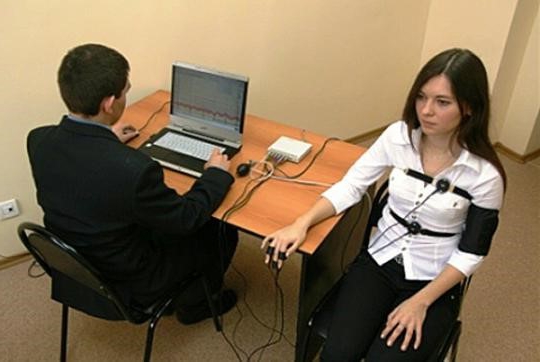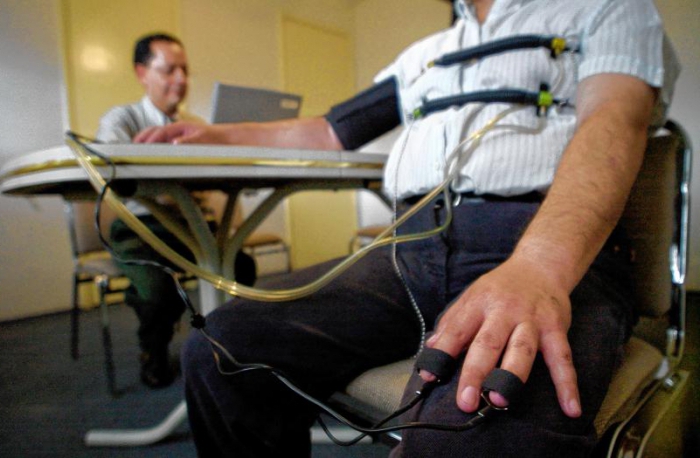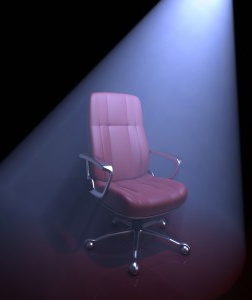A polygraph (another name is a lie detector) is used in forensics to determine the guilt of a suspect. Also, during employment in some companies, job seekers are waiting for a polygraph test. Thanks to this, the management receives information on whether potential employees have a tendency, for example, to theft, etc.

It should be noted right away that only people who have completed special courses and received a certificate of the required sample are allowed to test people on a polygraph.
Lie detector device
Before agreeing to pass the test on a polygraph, you should ask about its device and principle of operation. A lie detector is a sensor-type device that detects physiological parameters of a person by means of special sensors - blood pressure, heartbeat, muscle tone, blinking frequency, sweating, etc.
Sensors using wires connect to a computer, on the monitor of which you can see the results of the test in the form of various graphs.
It should be noted that attempts to "rig" the survey results have always been made. The question of how to deceive a polygraph exists as much as the lie detector itself.
What does testing look like?
Sensors are attached to the test from all sides. And in addition they seated on one more sensor and asked to remain motionless. The fact is that reactions to provocative questions even include involuntary muscle contractions.
Before starting the procedure, the subject must inform the inspector that he is worried about some questions or if he needs to go to the toilet. A comfortable state of the test person is a prerequisite for such a check, otherwise the results will be far from objective.
Also, at the beginning of the process, the device reads the initial parameters from the person. This is customary because many are concerned about the fact of verification, rather than hypothetical guilt. An honest and decent person may well be neurotic or simply overly impressionable. That is why the indicators obtained during the verification should be compared with the initial ones.

Is this test so serious?
In principle, a lie detector is quite realistic to deceive. Indeed, a polygraph check is carried out by a program based on measurements of your body’s physical parameters: pulse rate, respiration, blood pressure, etc. And if you keep calm when answering questions that you are asked, then the device will not perceive state changes.
At first glance, this is the whole secret of how to deceive a polygraph. But be aware that your effort to keep calm and control your own reactions will also be considered by the program. And, in turn, it will apply a "distraction maneuver" - for the first time (about twenty minutes) you will be asked the simplest questions in order to put down your vigilance and "adjust" the device specifically for you.
What may affect the result.
The main factor is the correct internal state of the subject. How to get through the polygraph according to all the rules? Anyone who is being tested must sit completely static, he is forbidden to move his arms, legs, eyes, head, strain any muscles and even swallow saliva. These actions can cause an involuntary physiological reaction, fixed by a polygraph and affecting the result.
So all the same - is it possible to pass a polygraph test with the result you need? Or, more simply, is it possible to trick the device?
If a person is accused of a serious crime, then sometimes a lie detector may be the only chance to prove his own innocence. Therefore, it is useful to have an idea of how to go through a polygraph in the Ministry of Internal Affairs.

How it's done
First of all, on the eve of testing, you should definitely get enough sleep. The answers to the questions on the polygraph should be given as truthful as possible, in case of any misunderstandings, everything should be explained as calmly as possible in detailed details.
If your biography contains any violations and other negative points, you should not be silent about them. It is much wiser to immediately frankly tell about them. A law-abiding citizen does not make sense at all.
How to get through a polygraph for your own benefit
Specialists working with the device assure that this is not easy. Only a person who has thoroughly studied the principle of his work and knows how to master himself is capable of outwitting a lie detector.
At first glance, maintaining external equanimity is not such a difficult task. But the detector captures and captures the parameters of the internal state! And it’s very, very difficult to control them. If a person in response to a question reveals a lie, his body reacts to a lie involuntarily, regardless of the desire to hide the truth. The device will only then be able to "swallow" a clear lie when the subject either sincerely believes in what he is saying or gives the answer "on the machine" - i.e. without analyzing your own words.

Tips for test takers
Do not focus on the significance of what is happening and do not immediately prepare for the worst. To successfully pass the test, you should simply relax, especially if you are not guilty of anything. In this case, the question of how to get through the polygraph simply should not bother you.
With this approach, your excitement will settle down, you will not begin to painfully sort through all your past sins. Suppose you are often asked whether there have been episodes of theft in your life. An honest and decent person, fundamentally unable to appropriate someone else’s, suddenly recalls a trifling children's episode - a toy taken without demand in a kindergarten.
This memory confuses him, the internal tension is immediately fixed by the device, and the honest answer "No" will be recorded as false. That is why in testing do not try to sort out past memories and do not delve deeply into the questions asked. Answer honestly, but at the same time slightly "mechanically" and rather indifferently.

How to achieve automatism
As already mentioned, a distant, calm state will help to deceive a polygraph - when a person does not try to form mental images of life situations in his mind. But this is not easy enough - to completely abandon and timely submit negative and positive answers, correctly alternating them. Truly, only a few succeed.
How to achieve the desired state? Try mentally switching to any other problem that is relevant to you. Thus, you sort of fenced off from the questions asked, respectively, do not analyze them and do not imagine the images of critical situations for you.
From the history of the lie detector
The first version of the polygraph was invented and used in 1895 by Italian psychiatrist Cesare Lombroso. The device was named by him as a hydrophygometer.
But a true lie detector, capable of assisting in the investigation of crimes, appeared only in 1921. He was invented by police officer John Larsen.
The polygraph was able to record the most insignificant changes in the psychophysical state of the subject, due to which the degree of truthfulness of his answers became clear to the specialist. This principle has long laid the foundation for the use of a lie detector and has been preserved to this day.

To whom the test is contraindicated
Lie detector testing is highly discouraged for people with mental illness, and just for those with a weak nervous system.
Women with a long gestation period have the right to refuse verification.In addition, it is forbidden to test adolescents under the age of majority. If necessary, they can be tested with the written permission of the parents (as well as those who care for the child) or in their presence.
An important point: passing a polygraph test is possible only with the written consent of the test subject - you must know this in order to prevent violation of your rights.
Now you know how to get through the polygraph competently. We hope this information will help you avoid mistakes and protect your own interests if necessary.